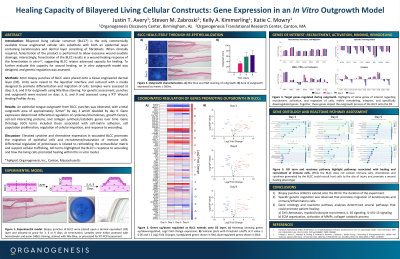Laboratory Research
(LR-001) Healing Capacity of Bi-layered Living Cellular Constructs: Gene Expression in an in Vitro Outgrowth Model
Friday, May 2, 2025
7:45 PM - 8:45 PM East Coast USA Time

Steven Zabroski, BS – Senior Process Development Associate, Organogenesis; Kelly Kimmerling, PhD – Senior Manager, R&D, Organogenesis; Katie Mowry, PhD – VP, R&D, Organogenesis
Introduction: Bi-layered living cellular construct (BLCC†) is the only commercially available tissue engineered cellular skin substitute with both an epidermal layer containing keratinocytes and dermal layer consisting of fibroblasts. When clinically required, fenestration of the product is performed to allow excessive wound exudate drainage; interestingly, fenestration of the BLCC results in a wound healing response of the fenestration in vitro1,2 suggesting BLCC retains advanced capacity for healing. To further evaluate this capacity for wound healing, an in vitro outgrowth model was designed and genetic regulation was assessed.
Methods: 4mm biopsy punches of BLCC were placed onto a tissue engineered dermal layer (DE). Units were raised to the liquid/air interface and cultured with a media designed to promote differentiation and migration of cells. Samples were assessed at days 3, 6, and 9 for outgrowth using Nile Blue staining. For genetic assessment, punches and outgrowth were excised on days 3, 6, and 9 and assessed using a RT2 Wound Healing Profiler Array.
Results: An epithelial tongue outgrowth from BLCC punches was observed, with a total outgrowth area of approximately 32mm2 by day 3 which doubled by day 9. Gene expression determined differential regulation of cytokines/chemokines, growth factors, cell-cell interacting proteins, and collagen synthesis/catabolic genes over time. Gene Ontology (GO) terms included those associated with cell-matrix adhesion, cell population proliferation, regulation of cellular migration, and response to wounding.
Discussion: Elevated cytokine and chemokine expression in wounded BLCC promotes the migration of epithelial cells and recruitment/maturation of immune cells. Differential regulation of proteinases is related to remodeling the extracellular matrix and support cellular trafficking. GO terms highlighted the BLCC’s response to wounding and how the living cells promoted healing within this in vitro model.
Methods: 4mm biopsy punches of BLCC were placed onto a tissue engineered dermal layer (DE). Units were raised to the liquid/air interface and cultured with a media designed to promote differentiation and migration of cells. Samples were assessed at days 3, 6, and 9 for outgrowth using Nile Blue staining. For genetic assessment, punches and outgrowth were excised on days 3, 6, and 9 and assessed using a RT2 Wound Healing Profiler Array.
Results: An epithelial tongue outgrowth from BLCC punches was observed, with a total outgrowth area of approximately 32mm2 by day 3 which doubled by day 9. Gene expression determined differential regulation of cytokines/chemokines, growth factors, cell-cell interacting proteins, and collagen synthesis/catabolic genes over time. Gene Ontology (GO) terms included those associated with cell-matrix adhesion, cell population proliferation, regulation of cellular migration, and response to wounding.
Discussion: Elevated cytokine and chemokine expression in wounded BLCC promotes the migration of epithelial cells and recruitment/maturation of immune cells. Differential regulation of proteinases is related to remodeling the extracellular matrix and support cellular trafficking. GO terms highlighted the BLCC’s response to wounding and how the living cells promoted healing within this in vitro model.

.jpg)